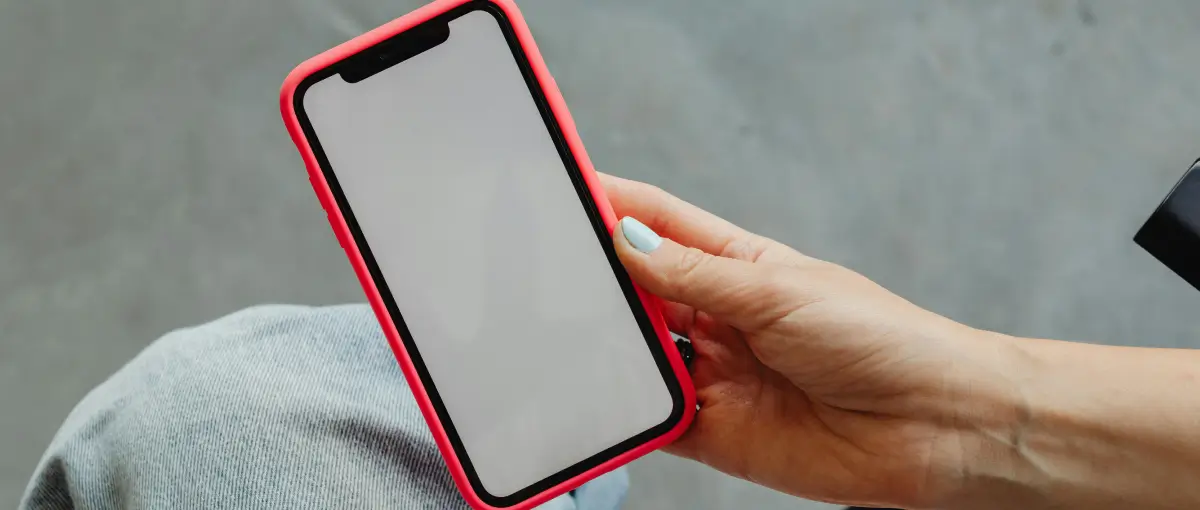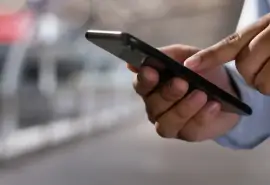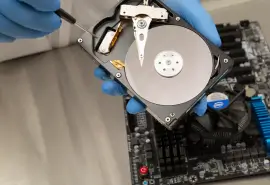When your iPhone screen suddenly turns white and stops responding, it can be a frustrating and confusing situation to deal with. This issue, commonly known as the iPhone white screen of death, can affect any model, from older devices like the iPhone 6s and iPhone 7 to the iPhone 13 Pro Max, iPhone 14, iPhone 15, and even the latest iPhone 16. It’s not limited to iPhones either; iPads and iPods running iOS can also experience this problem.
Sometimes the white screen appears after an iOS update, a drop, or water damage. In other cases, it shows up with no clear cause at all. While the problem is occasionally the result of a minor software glitch or an interrupted update, it can also signal something more serious, like firmware corruption or underlying hardware damage that requires professional attention.
We’ll take a closer look at what causes the iPhone white screen, how to fix it safely, and when it’s time to turn to experts like Secure Data Recovery to recover your data.
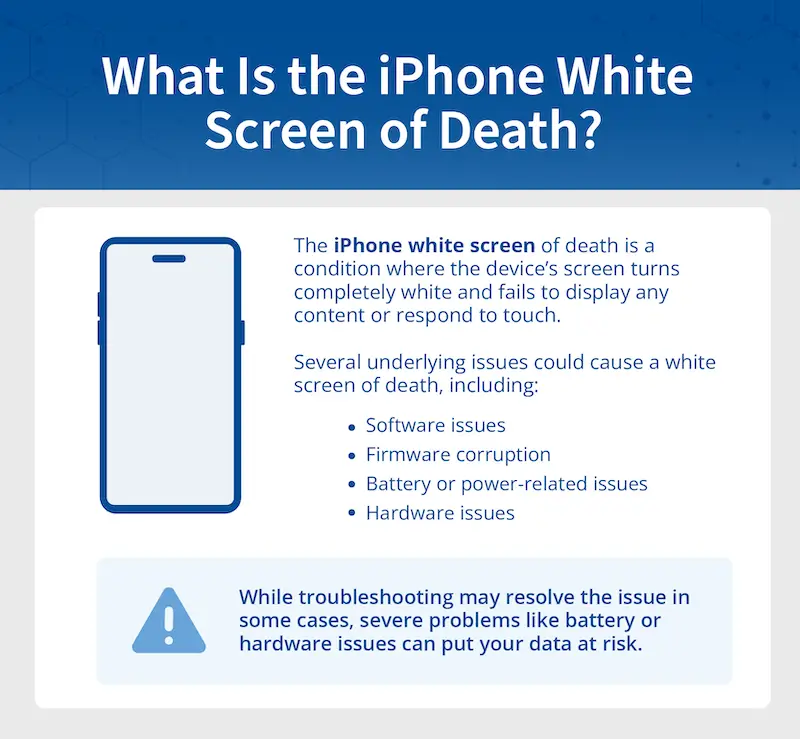
Common causes of the iPhone white screen of death
The iPhone white screen can happen for a variety of reasons, from small software issues to more serious hardware problems. In some cases, it’s triggered by something specific, like a failed update, a jailbreak attempt, or physical damage. But other times, the white screen appears without any clear cause at all.
Understanding what’s behind the issue can help you figure out whether it’s something you can troubleshoot yourself or if it’s time to call in an expert. Below is a breakdown of the most common causes, starting with problems that are typically fixable at home and ending with those that are best handled by a professional.
System zoom glitch
The iOS zoom feature can sometimes be activated at maximum magnification, making the screen look completely white.
Likelihood of DIY fix - High: Easily fixable with a simple, non-invasive solution
Recommended next steps: Check for a zoom glitch by triple-tapping the screen with three fingers.
Software glitches or failed iOS updates
Incomplete or interrupted iOS updates (like a failed iOS 17 or iOS 18 update) can freeze the system on a white screen.
Likelihood of DIY fix - High: Typically fixable with some moderate to advanced troubleshooting
Recommended next steps: First, try force restarting your iPhone. If this white screen persists, enter recovery mode and attempt an update. If the update fails to work, you may need to perform a Restore.
Firmware corruption
Corrupted firmware, often caused by interrupted updates or restore attempts, can lead to continuous reboots or a white screen stuck on the Apple logo.
Likelihood of DIY fix - Moderate: Possible to fix with more advanced troubleshooting
Recommended next steps: Try performing a Restore. If the Restore does not fix the white screen, use DFU mode.
Jailbreak attempts
Installing unauthorized firmware can conflict with iOS, causing instability and white screen issues.
Likelihood of DIY fix - Moderate: Possible to fix with advanced troubleshooting, but may need professional help
Recommended next steps: Use DFU mode to restore your device. If the white screen persists, contact a data recovery expert.
Battery or power-related issues
A failing iPhone battery or faulty charging components can disrupt startup and lead to a white screen.
Likelihood of DIY fix - Low: Involves hardware diagnostics and is not DIY-friendly
Recommended next steps: Look for hardware or power-related signs and seek professional help.
Hardware issues
Damage to the LCD, motherboard, or internal connectors (often from drops or water exposure) can cause persistent white screen problems.
Likelihood of DIY fix - Low: Requires specialized tools and expertise; not DIY-friendly
Recommended next steps: Check for hardware or power-related signs and contact a professional.
Understanding why your iPhone is stuck on a white screen is key to choosing the right solution. Once you have a sense of the underlying cause, you can troubleshoot with more confidence, whether that means trying a safe fix yourself or knowing when to stop and seek expert help. Taking the time to identify the problem up front can prevent unnecessary risks and increase the chances of restoring your device successfully.
How to fix iPhone white screen issues
When attempting to fix an iPhone stuck on a white screen, it’s helpful to follow a clear, step-by-step process. We recommend starting with the safest, simplest solutions that carry no risk of data loss and only moving on to more advanced methods if necessary.
Jumping straight into resets or restores without understanding the risks can lead to further complications or even permanent data loss. If your iPhone contains important information that hasn’t been backed up, it’s worth contacting an iPhone data recovery service before trying anything that could erase your data.
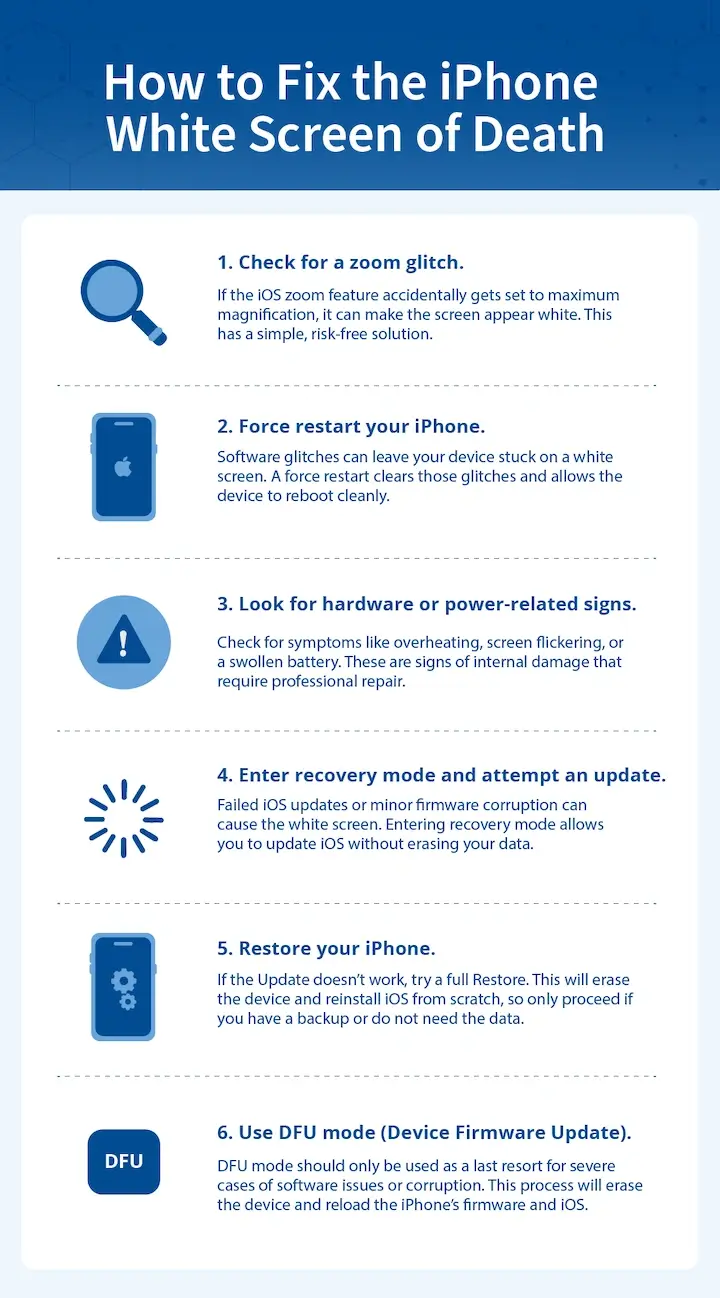
1. Check for a zoom glitch
One of the most overlooked causes of a white screen is the system zoom glitch, where the iOS zoom feature accidentally gets set to maximum magnification. This makes the screen appear white even though the phone is functioning normally. Fortunately, this is one of the easiest fixes and poses no risk to your device or your data.
To fix a zoom glitch: Triple-tap the screen with three fingers to disable zoom.
If triple-tapping doesn’t fix the white screen issue, the problem may be software-related rather than a zoom glitch. In that case, continue to force restart your iPhone (method 2) to move forward with troubleshooting.
2. Force restart your iPhone
Temporary software glitches or incomplete system processes (often caused by software problems or minor firmware hiccups) can leave your device frozen on a white screen. A force restart, also known as a hard reset, is a simple and safe way to clear out these temporary issues and prompt the device to reboot cleanly. This method doesn’t erase any data and is a good first step if the screen remains white after checking for a zoom glitch.
To force restart your iPhone:
- For iPhone 8 or newer models:
- Quickly press and release the Volume Up button.
- Quickly press and release the Volume Down button.
- Hold the Side button (power button) until the Apple logo appears.
- For iPhone 7 and 7 Plus:
- Press and hold the Volume Down button and the Power button at the same time.
- Release both buttons when the Apple logo appears.
- For iPhone 6s or older models:
- Press and hold the Home button and the Power button at the same time.
- Release both buttons when the Apple logo appears.
If your iPhone restarts normally, the issue was likely just a temporary software glitch. If the white screen remains, we recommend checking for hardware or power-related signs (method 3) before moving on to more advanced solutions.
3. Look for hardware or power-related signs
Before jumping into more advanced troubleshooting, it’s important to rule out potential hardware or power-related issues. Problems like a damaged LCD, motherboard failure, or battery and power-related faults can all cause a white screen, and these can’t be fixed through software.
Look for symptoms such as screen flickering, overheating, swelling near the battery, or an unresponsive power button. These symptoms often point to internal damage that requires professional diagnostics and repair. Continuing with software-based troubleshooting won’t resolve the problem and may even make things worse.
If you spot any of these signs, it’s best to stop and schedule an iPhone data recovery as soon as possible. This ensures your data is protected before further damage occurs.
If you don’t notice any signs of hardware failure or power issues, you can move on to more advanced troubleshooting methods in the next steps.
4. Enter recovery mode and attempt an update
If your iPhone’s white screen is caused by a failed iOS update or minor firmware corruption, entering recovery mode allows you to reinstall the operating system without erasing your data. This is a safe next step after basic troubleshooting and is often successful in restoring the device. Be sure to select Update, not Restore, as this will attempt to repair the system while preserving your files and settings.
How to perform an Update:
- Connect your iPhone to a computer with a USB cable:
- On a Windows PC: Ensure iTunes is installed and updated.
- On a Mac: Open Finder (macOS Catalina or later) or iTunes (earlier macOS versions).
- Put your iPhone into Recovery Mode:
- iPhone 8 or newer: Press and release the Volume Up button, then the Volume Down button, and hold the Side button until you see the recovery mode screen.
- iPhone 7 and 7 Plus: Press and hold the Volume Down button and the Power button together until the recovery mode screen appears.
- iPhone 6s or older: Press and hold the Home button and the Power button until the recovery mode screen appears.
- When prompted on your computer, select Update (not Restore) to reinstall iOS without erasing your data.
- Follow the on-screen instructions to complete the update.
If the update completes successfully, your iPhone should reboot normally. If the update fails to resolve the white screen, proceed to Restore your iPhone (method 5) for a more advanced solution.
5. Restore your iPhone (if the update fails)
If the Update option in recovery mode doesn’t resolve the white screen, the next step is to perform a full Restore (also known as a factory reset). This process erases your iPhone completely and reinstalls a fresh version of iOS. It can resolve deeper system problems, but because it will also delete everything on your device, only proceed if you’ve already backed up your data or no longer need it.
If your iPhone contains important data that you want to preserve, stop here and contact Secure Data Recovery for iPhone recovery services before proceeding.
To restore your iPhone:
- Connect your iPhone to a Windows PC or Mac.
- Open iTunes (or Finder on macOS Catalina or later).
- Put your iPhone into recovery mode (following the instructions outlined in method 4).
- Once in recovery mode, you’ll see options to Update or Restore in iTunes or Finder. Choose Restore to erase your iPhone and reinstall the operating system.
- Follow the on-screen instructions to complete the restore process.
If the Restore is successful, your iPhone should reboot to the setup screen. If the white screen returns, you may need to move on to DFU mode (method 6) as a last resort.
6. Use DFU mode (Device Firmware Update)
DFU mode is the most advanced iPhone recovery option and should only be used as a last resort. Unlike standard recovery mode, DFU mode bypasses iOS, allowing your computer to reload the device’s firmware and operating system from scratch. It’s especially useful if the white screen is caused by serious firmware corruption, repeated failed restore attempts, or system instability from jailbreaking.
Be aware that using DFU mode and completing a restore will erase your iPhone completely. Only use this method if you’ve already backed up your data or if you no longer need the information stored on the device. If you want to recover important files first, it’s best to schedule iPhone data recovery before proceeding.
How to use DFU mode:
- Connect your iPhone to a Windows PC or Mac.
- Enter DFU mode on your iPhone:
- iPhone 8 or newer models:
- Quickly press and release the Volume Up button, then the Volume Down button.
- Hold the Side button until the screen goes black.
- Release the Side button and immediately hold the Volume Down button and the Side button together for 5 seconds.
- Release the Side button but continue holding the Volume Down button for another 10 seconds.
- iPhone 7 and 7 Plus:
- Hold the Power button and the Volume Down button together for 8 seconds.
- Release the Power button but continue holding the Volume Down button for another 10 seconds.
- iPhone 6s or older models:
- Hold the Home button and the Power button together for 8 seconds.
- Release the Power button but continue holding the Home button for another 10 seconds.
- iPhone 8 or newer models:
- The screen should remain black, indicating DFU mode.
- iTunes or Finder will detect your iPhone in DFU mode and prompt you to restore the device.
- Follow the on-screen prompts on your Mac or PC to reinstall iOS.
If DFU mode does not fix the white screen, the underlying issue is most likely hardware-related rather than software-related, and will require professional diagnostics and repair.
What to do if the white screen persists after troubleshooting
If you’ve gone through all the troubleshooting steps and your iPhone is still stuck on a white screen or if your iPhone keeps restarting, the issue is likely more serious than a simple software glitch. At this stage, continuing to attempt force restarts, factory resets, or advanced fixes could make the situation worse or lead to permanent data loss.
Watch for signs of hardware failure, such as screen flickering, overheating, or unresponsive buttons. These symptoms usually indicate a physical problem rather than a software one and require professional diagnostics.
If your iPhone is still under warranty or covered by AppleCare, you may want to visit an Apple Store or contact Apple Support. However, if your device holds important data that you want to recover before any repair or replacement is done, Secure Data Recovery can help. Our team has the tools and expertise to safely recover data from an iPhone that’s stuck on a white screen.
Tips to keep your iPhone running smoothly and prevent white screen issues
Not every white screen issue can be prevented, but there are practical steps you can take to reduce the chances of it happening. Following a few simple best practices can help keep your iPhone stable, avoid both software and hardware problems, and protect your data in the event something does go wrong.
1. Keep your iOS updated
Apple’s software updates include critical security patches and stability improvements that help prevent system glitches. Always update over a stable internet connection with sufficient battery or while plugged in, and never interrupt the process. Cutting an update short can lead to firmware corruption or white screen errors.
2. Restart your device regularly
Restarting your iPhone once a week helps clear out temporary glitches and keeps iOS running smoothly. This small habit can prevent minor bugs from escalating into more serious performance issues.
3. Avoid jailbreaking
While jailbreaking may offer more control over your device, it also compromises system stability and increases the likelihood of conflicts that can trigger white screen problems. Sticking with official iOS software ensures your device stays secure and reliable.
4. Don’t interrupt system processes
Interrupting an update or restore by force quitting, disconnecting your device, or running out of power is a common cause of firmware corruption that can lead to white screen problems. To avoid this, make sure your iPhone is charged, connected securely, and left undisturbed during any updates or restores.
5. Protect your device from physical damage
Hardware damage, such as cracked screens, loose internal connections, or battery swelling, often leads to persistent white screen issues. Use a protective case, avoid water exposure, and monitor your battery health to reduce the risk of hardware-related problems.
6. Back up your data frequently
Keeping regular backups ensures that if something does go wrong, your data is safe and easily recoverable. Use iCloud or connect your device to a computer regularly so you’re prepared for unexpected issues or repairs.
By following these simple habits, you can significantly reduce the chances of running into frustrating problems like a white or black screen and keep your iPhone running smoothly. Prevention is always easier and often far less costly than repair, and taking consistent care of both your device and your data helps you avoid unnecessary stress down the line.
Fixing iPhone white screen issues safely and effectively
A white screen on your iPhone can be frustrating and disruptive, especially when it seems to appear without warning. The good news is that in many cases, it can be resolved by following a clear and careful troubleshooting process.
Starting with simple solutions and gradually moving to more advanced methods gives you the best chance of fixing the issue without putting your data at risk. And if the problem turns out to be more serious, like hardware failure, knowing when to stop and seek expert help is just as important.
If you’re dealing with a persistent white screen or you’re concerned about losing valuable data, it’s best to avoid unnecessary risks. At Secure Data Recovery, we offer trusted iPhone data recovery services to safely recover your files. Our team has the tools and experience to handle even the most complex white screen problems with confidence.

